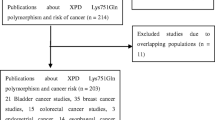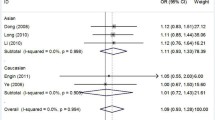Abstract
The published data on the association between xeroderma pigmentosum group D (XPD) Lys751Gln polymorphism and esophageal cancer (EC) remained controversial. The present meta-analysis of literatures was performed to derive a more precise estimation of the relationship. A comprehensive literature search was conducted to identify all case–control studies of Lys751Gln polymorphism and risk for two main types of EC: esophageal adenocarcinoma (EADC) and esophageal squamous cell carcinoma (ESCC). A total of 12 studies were identified to the meta-analysis, including 2,575 cases (1,294 ESCC and 1,281 EADC) and 4,951 controls (1,891 ESCC and 3,060 EADC). Random-effects or fix-effects model was used according to between-study heterogeneity. The odds ratio (OR) for the variant homozygous genotype Gln/Gln of the Lys751Gln polymorphism, compared with the wild type homozygote Lys/Lys, was 1.26, with 95% confidence interval (95% CI) 1.02–1.56, for EADC risk without between-study heterogeneity. When stratified by ethnicity, statistically significantly elevated risk was found among Chinese (Gln/Gln vs. Lys/Lys: OR 2.45, 95% CI = 1.10–5.44). However, no significant associations were found between XPD Lys751Gln polymorphism and EC risk when all studies pooled into the meta-analysis (Lys/Gln vs. Lys/Lys: OR 1.07, 95% CI = 0.88–1.28; Gln/Gln vs.us Lys/Lys: OR 1.25, 95% CI = 0.92–1.71; dominant model: OR 1.09, 95% CI = 0.90–1.33). In conclusion, this meta-analysis suggests that the Lys751Gln genetic polymorphism may be a potential biomarker of EC susceptibility in Chinese populations. And a study with the larger sample size is needed to further evaluate gene–environment interaction on XPD Lys751Gln polymorphism and EC risk.



Similar content being viewed by others
References
Parkin DM, Bray F, Ferlay J, Pisani P (2005) Global cancer statistics, 2002. CA Cancer J Clin 55:74–108
American Cancer Society (2008) Cancer facts and figures 2008. American Cancer Society, Atlanta
Xing D, Tan W, Lin D (2003) Genetic polymorphisms and susceptibility to esophageal cancer among Chinese population (review). Oncol Rep 10:1615–1623
Botterweck AAM, Schouten LJ, Volovics A, Dorant E, Van den Brandt PA (2000) Trends in incidence of adenocarcinoma of the esophagus and gastric cardia in ten European countries. Int J Epidemiol 29:645–654
Blot WJ, McLaughlin JK (1999) The changing epidemiology of esophageal cancer. Semin Oncol 26:2–8
Hoeijmakers JH (2001) Genome maintenance mechanisms for preventing cancer. Nature 411:366–374
Wood RD, Mitchell M, Sgouros J, Lindahl T (2001) Human DNA repair genes. Science 291:1284–1289
Duell EJ, Wiencke JK, Cheng TJ, Varkonyi A, Zuo ZF, Ashok TD, Mark EJ, Wain JC, Christiani DC, Kelsey KT (2000) Polymorphisms in the DNA repair genes XRCC1 and ERCC2 and biomarkers of DNA damage in human blood mononuclear cells. Carcinogenesis 21:965–971
Benhamou S, Sarasin A (2005) ERCC2/XPD gene polymorphisms and lung cancer: a HuGE review. Am J Epidemiol 161:1–14
Coin F, Marinoni JC, Rodolfo C, Fribourg S, Pedrini AM, Egly JM (1998) Mutations in the XPD helicase gene result in XP and TTD phenotypes, preventing interaction between XPD and the p44 subunit of TFIIH. Nat Genet 20:184–188
Spitz MR, Wu X, Wang Y, Wang LE, Shete S, Amos CI, Guo Z, Lei L, Mohrenweiser H, Wei Q (2001) Modulation of nucleotide excision repair capacity by XPD polymorphisms in lung cancer patients. Cancer Res 61:1354–1357
Shen H, Spitz MR, Qiao Y, Guo Z, Wang LE, Bosken CH, Amos CI, Wei Q (2003) Smoking, DNA repair capacity and risk of nonsmall cell lung cancer. Int J Cancer 107:84–88
Shi Q, Wang LE, Bondy ML, Brewster A, Singletary SE, Wei Q (2004) Reduced DNA repair of benzo[a]pyrene diol epoxideinduced adducts and common XPD polymorphisms in breast cancer patients. Carcinogenesis 13:1081–1083
Ramos JM, Ruiz A, Colen R, Lopez ID, Grossman L, Matta JL (2004) DNA repair and breast carcinoma susceptibility in women. Cancer 100:1352–1357
Wei Q, Lee JE, Gershenwald JE, Ross MI, Mansfield PF, Strom SS, Wang LE, Guo Z, Qiao Y, Amos CI, Spitz MR, Duvic M (2003) Repair of UV light-induced DNA damage and risk of cutaneous malignant melanoma. J Natl Cancer Inst 95:308–315
Hu JJ, Hall MC, Grossman L, Hedayati M, McCullough DL, Lohman K, Case LD (2004) Deficient nucleotide excision repair capacity enhances human prostate cancer risk. Cancer Res 64:1197–1201
Hemminki K, Xu G, Angelini S, Snellman E, Jansen CT, Lambert B, Hou SM (2001) XPD exon 10 and 23 polymorphisms and DNA repair in human skin in situ. Carcinogenesis 22:1185–1188
Benhamou S, Sarasin A (2002) ERCC2/XPD gene polymorphisms and cancer risk. Mutagenesis 17:463–469
Liu G, Zhou W, Yeap BY, Su L, Wain JC, Poneros JM, Nishioka NS, Lynch TJ, Christiani DC (2007) XRCC1 and XPD polymorphisms and esophageal adenocarcinoma risk. Carcinogenesis 28:1254–1258
Ferguson HR, Wild CP, Anderson LA, Murphy SJ, Johnston BT, Murray LJ, Watson RG, McGuigan J, Reynolds JV, Hardie LJ (2008) No association between hOGG1, XRCC1, and XPD polymorphisms and risk of reflux esophagitis, Barrett’s esophagus, or esophageal adenocarcinoma: results from the factors influencing the Barrett’s adenocarcinoma relationship case–control study. Cancer Epidemiol Biomark Prev 17:736–739
Tse D, Zhai R, Zhou W, Heist RS, Asomaning K, Su L, Lynch TJ, Wain JC, Christiani DC, Liu G (2008) Polymorphisms of the NER pathway genes, ERCC1 and XPD are associated with esophageal adenocarcinoma risk. Cancer Causes Control 19:1077–1083
Casson AG, Zheng Z, Evans SC, Veugelers PJ, Porter GA, Guernsey DL (2005) Polymorphisms in DNA repair genes in the molecular pathogenesis of esophageal (Barrett) adenocarcinoma. Carcinogenesis 26:1536–1541
Ye W, Kumar R, Bacova G, Lagergren J, Hemminki K, Nyren O (2006) The XPD 751Gln allele is associated with an increased risk for esophageal adenocarcinoma: a population-based case-control study in Sweden. Carcinogenesis 27:1835–1841
Doecke J, Zhao ZZ, Pandeya N, Sadeghi S, Stark M, Green AC, Hayward NK, Webb PM, Whiteman DC (2008) Polymorphisms in MGMT and DNA repair genes and the risk of esophageal adenocarcinoma. Int J Cancer 123:174–180
Pan J, Lin J, Izzo JG, Liu Y, Xing J, Huang M, Ajani JA, Wu X (2009) Genetic susceptibility to esophageal cancer: the role of the nucleotide excision repair pathway. Carcinogenesis 30:785–792
Yu HP, Wang XL, Sun X, Su YH, Wang YJ, Lu B, Shi LY, Xiong CL, Li YY, Li F, Xu SQ (2004) Polymorphisms in the DNA repair gene XPD and susceptibility to esophageal squamous cell carcinoma. Cancer Genet Cytogenet 154:10–15
Zhai XD, Mo YN, Xue XQ, Zhao GS, Gao LB, Ai HW, Ye Y (2009) XRCC1 codon 280 and ERCC2 codon 751 polymorphisms and risk of esophageal squamous cell carcinoma in a Chinese population. Bull Cancer 96:E61–E65
Xing D, Qi J, Miao X, Lu W, Tan W, Lin D (2002) Polymorphisms of DNA repair genes XRCC1 and XPD and their associations with risk of esophageal squamous cell carcinoma in a Chinese population. Int J Cancer 100:600–605
Sobti RC, Singh J, Kaur P, Pachouri SS, Siddiqui EA, Bindra HS (2007) XRCC1 codon 399 and ERCC2 codon 751 polymorphism, smoking, and drinking and risk of esophageal squamous cell carcinoma in a North Indian population. Cancer Genet Cytogenet 175:91–97
Xing DY, Qi J, Tan W, Miao XP, Liang G, Yu CY, Lu WF, Zhou CN, Wu M, Lin DX (2003) Association of genetic polymorphisms in the DNA repair gene XPD with risk of lung and esophageal cancer in a Chinese population in Beijing. Zhonghua Yi Xue Yi Chuan Xue Za Zhi 20:35–38
DerSimonian R, Laird N (1986) Meta-analysis in clinical trials. Control Clin Trials 7:177–188
Mantel N, Haenszel W (1959) Statistical aspects of the analysis of data from retrospective studies of disease. J Natl Cancer Inst 22:719–748
Egger M, Davey Smith G, Schneider M, Minder C (1997) Bias in meta-analysis detected by a simple, graphical test. BMJ 315:629–634
Cleaver JE (2000) Common pathways for ultraviolet skin carcinogenesis in the repair and replication defective groups of xeroderma pigmentosum. J Dermatol Sci 23:1–11
Au WW, Navasumrit P, Ruchirawat M (2004) Use of biomarkers to characterize functions of polymorphic DNA repair genotypes. Int J Hyg Environ Health 107:301–313
Vodicka P, Kumar R, Stetina R, Sanyal S, Soucek P, Haufroid V, Dusinska M, Kuricova M, Zamecnikova M, Musak L, Buchancova J, Norppa H, Hirvonen A et al (2004) Genetic polymorphisms in DNA repair genes and possible links with DNA repair rates, chromosomal aberrations and single-strand breaks in DNA. Carcinogenesis 25:757–763
Pavanello S, Pulliero A, Siwinska E, Mielzynska D, Clonfero E (2005) Reduced nucleotide excision repair and GSTM1-null genotypes influence anti-B[a]PDE–DNA adduct levels in mononuclear white blood cells of highly PAH-exposed coke oven workers. Carcinogenesis 26:169–175
Hirschhorn JN, Lohmueller K, Byrne E (2002) A comprehensive review of genetic association studies. Genet Med 4:45–61
Cheng KK, Duffy SW, Day NE, Lam TH (1995) Oesophageal cancer in never-smokers and never-drinkers. Int J Cancer 60:820–822
Garidou A, Tzonou A, Lipworth L, Signorello LB, Kalapothaki V, Trichopoulos D (1996) Life-style factors and medical conditions in relation to esophageal cancer by histologic type in a low-risk population. Int J Cancer 68:295–299
Launoy G, Milan CH, Faivre J, Pienkowski P, Milan CI, Gignoux M (1997) Alcohol, tobacco and oesophageal cancer: effects of the duration of consumption, mean intake and current and former consumption. Br J Cancer 75:1389–1396
Author information
Authors and Affiliations
Corresponding authors
Rights and permissions
About this article
Cite this article
Ding, DP., Ma, WL., He, XF. et al. XPD Lys751Gln polymorphism and esophageal cancer susceptibility: a meta-analysis of case–control studies. Mol Biol Rep 39, 2533–2540 (2012). https://doi.org/10.1007/s11033-011-1005-x
Received:
Accepted:
Published:
Issue Date:
DOI: https://doi.org/10.1007/s11033-011-1005-x




